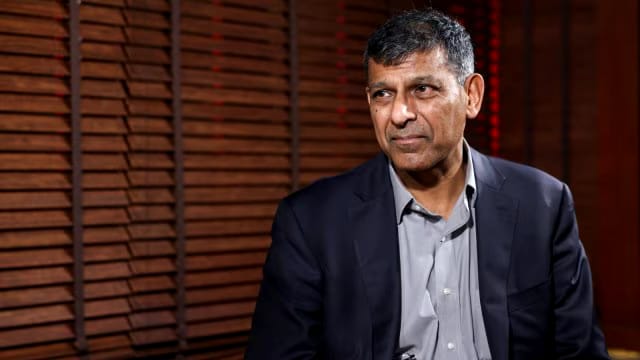If it is business as usual, Viksit Bharat by 2047 will not happen: Raghuram Rajan
Raghuram Rajan, former RBI Governor and former Chief Economic Advisor, spoke to The Indian Express’s Udit Misra about a wide variety of topics ranging from inflation to GDP growth to the impact of possible global trade war under President-elect Donald Trump’s second term. Edited Excerpts.
Q: From people’s perspective, overall affordability could become worse despite the inflation rate coming down. Some academics argue inflation targeting is not suited for India. Others, even within the government, suggest ignoring food inflation. What is your take?
A: I think the reason that we targeted headline inflation (CPI) rather than core CPI (inflation without food and fuel prices), is because food is such a big part of the Indian consumption basket; to ignore it is to ignore
So you may say, as RBI says, core inflation is coming down, but if your food inflation is high, people are hurting and they’re saying, “What world are you living in? You don’t see the fact that we are hurting”.
Q: What can the government do, or could have done, to contain inflation?
A: That is the real challenge that we have, right? If you look at our GDP level relative to what it would be if we had grown at 6% steadily through the pandemic, we are about 6% below one year of growth. Below that one year means a lot of jobs (lost).
But also, what is important is our economy itself is not creating enough jobs. Manufacturing, for example, is becoming much more capital intensive over time. Where we are creating jobs is in construction and agriculture. Construction, of course, because of the boom in infrastructure spending, etc, is understandable. Agriculture is worrisome. Why are people going back to agriculture when, in fact, in every developing country, they should be coming out into the services and manufacturing.
Services was creating jobs, but through the pandemic, it has not.
I think the big question for the government has to be: How do we create more jobs and higher quality jobs?
: Just before Covid hit, India’s growth rate was less than 4% and there was a secular deceleration that was happening over the three years preceding Covid. Why did we have this massive jump for three straight years?
A: Well, recoveries are not immediate, right? So remember, there were a few quarters of really negative growth, strongly negative growth during the pandemic. So the sort of spring back, the recovery has boosted growth over two or three years. Now, I thought where you were going is: Is our real rate of growth the 2019 rate (4%) or 6%?
The 4% growth rate would be terrible if we go back to that. My hope is that we may have another quarter of low growth, but we go back eventually to six. But even with six, you know, it’s not enough.
Q: For an economy like India where even a 4% GDP growth rate looks like a stagnant economy. And while it is not exactly stagflation at present, is India facing something similar to a stagflationary scenario?
A: Oh, 4% is deep recession from our perspective…I think if we go down to four, we are in a terrible situation. Remember, we are in the sweet spot that every East Asian economy was when it got a population dividend: A lot of young people coming into the labour force, and reducing the dependency rate — that is, the old and the very young who cannot work. So our working population — working-age population as a fraction of the population — is growing. This is when our growth should, even relative to the recent past, go up by a percentage point or two if we create the jobs for the people coming into the workforce. The fact that we’re not growing faster now is really worrisome, right? In other words, I keep saying 6% won’t cut it, but it should be more than 6% just from the population dividend. It should be even more for us to achieve that goal of “viksit desh” by 2047 and if it’s business as usual, it’s not going to happen.
If you look at our GDP level relative to what it would be if we had grown at 6% steadily through the pandemic, we are about 6% below one year of growth. Below that one year means a lot of jobs (lost).
But also, what is important is our economy itself is not creating enough jobs. Manufacturing, for example, is becoming much more capital intensive over time. Where we are creating jobs is in construction and agriculture. Construction, of course, because of the boom in infrastructure spending, etc, is understandable. Agriculture is worrisome. Why are people going back to agriculture when, in fact, in every developing country, they should be coming out into the services and manufacturing.
Services was creating jobs, but through the pandemic, it has not.
I think the big question for the government has to be: How do we create more jobs and higher quality jobs?
: Just before Covid hit, India’s growth rate was less than 4% and there was a secular deceleration that was happening over the three years preceding Covid. Why did we have this massive jump for three straight years?
A: Well, recoveries are not immediate, right? So remember, there were a few quarters of really negative growth, strongly negative growth during the pandemic. So the sort of spring back, the recovery has boosted growth over two or three years. Now, I thought where you were going is: Is our real rate of growth the 2019 rate (4%) or 6%?
The 4% growth rate would be terrible if we go back to that. My hope is that we may have another quarter of low growth, but we go back eventually to six. But even with six, you know, it’s not enough.
Q: For an economy like India where even a 4% GDP growth rate looks like a stagnant economy. And while it is not exactly stagflation at present, is India facing something similar to a stagflationary scenario?
A: Oh, 4% is deep recession from our perspective…I think if we go down to four, we are in a terrible situation. Remember, we are in the sweet spot that every East Asian economy was when it got a population dividend: A lot of young people coming into the labour force, and reducing the dependency rate — that is, the old and the very young who cannot work. So our working population — working-age population as a fraction of the population — is growing. This is when our growth should, even relative to the recent past, go up by a percentage point or two if we create the jobs for the people coming into the workforce. The fact that we’re not growing faster now is really worrisome, right? In other words, I keep saying 6% won’t cut it, but it should be more than 6% just from the population dividend. It should be even more for us to achieve that goal of “viksit desh” by 2047 and if it’s business as usual, it’s not going to happen.

 If you look at our GDP level relative to what it would be if we had grown at 6% steadily through the pandemic, we are about 6% below one year of growth. Below that one year means a lot of jobs (lost).
But also, what is important is our economy itself is not creating enough jobs. Manufacturing, for example, is becoming much more capital intensive over time. Where we are creating jobs is in construction and agriculture. Construction, of course, because of the boom in infrastructure spending, etc, is understandable. Agriculture is worrisome. Why are people going back to agriculture when, in fact, in every developing country, they should be coming out into the services and manufacturing.
Services was creating jobs, but through the pandemic, it has not.
I think the big question for the government has to be: How do we create more jobs and higher quality jobs?
: Just before Covid hit, India’s growth rate was less than 4% and there was a secular deceleration that was happening over the three years preceding Covid. Why did we have this massive jump for three straight years?
A: Well, recoveries are not immediate, right? So remember, there were a few quarters of really negative growth, strongly negative growth during the pandemic. So the sort of spring back, the recovery has boosted growth over two or three years. Now, I thought where you were going is: Is our real rate of growth the 2019 rate (4%) or 6%?
The 4% growth rate would be terrible if we go back to that. My hope is that we may have another quarter of low growth, but we go back eventually to six. But even with six, you know, it’s not enough.
Q: For an economy like India where even a 4% GDP growth rate looks like a stagnant economy. And while it is not exactly stagflation at present, is India facing something similar to a stagflationary scenario?
A: Oh, 4% is deep recession from our perspective…I think if we go down to four, we are in a terrible situation. Remember, we are in the sweet spot that every East Asian economy was when it got a population dividend: A lot of young people coming into the labour force, and reducing the dependency rate — that is, the old and the very young who cannot work. So our working population — working-age population as a fraction of the population — is growing. This is when our growth should, even relative to the recent past, go up by a percentage point or two if we create the jobs for the people coming into the workforce. The fact that we’re not growing faster now is really worrisome, right? In other words, I keep saying 6% won’t cut it, but it should be more than 6% just from the population dividend. It should be even more for us to achieve that goal of “viksit desh” by 2047 and if it’s business as usual, it’s not going to happen.
If you look at our GDP level relative to what it would be if we had grown at 6% steadily through the pandemic, we are about 6% below one year of growth. Below that one year means a lot of jobs (lost).
But also, what is important is our economy itself is not creating enough jobs. Manufacturing, for example, is becoming much more capital intensive over time. Where we are creating jobs is in construction and agriculture. Construction, of course, because of the boom in infrastructure spending, etc, is understandable. Agriculture is worrisome. Why are people going back to agriculture when, in fact, in every developing country, they should be coming out into the services and manufacturing.
Services was creating jobs, but through the pandemic, it has not.
I think the big question for the government has to be: How do we create more jobs and higher quality jobs?
: Just before Covid hit, India’s growth rate was less than 4% and there was a secular deceleration that was happening over the three years preceding Covid. Why did we have this massive jump for three straight years?
A: Well, recoveries are not immediate, right? So remember, there were a few quarters of really negative growth, strongly negative growth during the pandemic. So the sort of spring back, the recovery has boosted growth over two or three years. Now, I thought where you were going is: Is our real rate of growth the 2019 rate (4%) or 6%?
The 4% growth rate would be terrible if we go back to that. My hope is that we may have another quarter of low growth, but we go back eventually to six. But even with six, you know, it’s not enough.
Q: For an economy like India where even a 4% GDP growth rate looks like a stagnant economy. And while it is not exactly stagflation at present, is India facing something similar to a stagflationary scenario?
A: Oh, 4% is deep recession from our perspective…I think if we go down to four, we are in a terrible situation. Remember, we are in the sweet spot that every East Asian economy was when it got a population dividend: A lot of young people coming into the labour force, and reducing the dependency rate — that is, the old and the very young who cannot work. So our working population — working-age population as a fraction of the population — is growing. This is when our growth should, even relative to the recent past, go up by a percentage point or two if we create the jobs for the people coming into the workforce. The fact that we’re not growing faster now is really worrisome, right? In other words, I keep saying 6% won’t cut it, but it should be more than 6% just from the population dividend. It should be even more for us to achieve that goal of “viksit desh” by 2047 and if it’s business as usual, it’s not going to happen.



